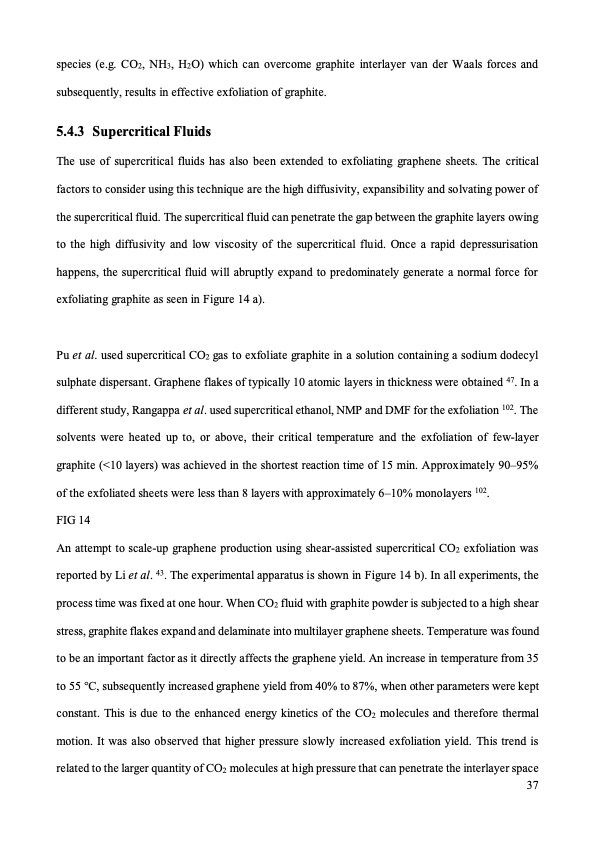
PDF Publication Title:
Text from PDF Page: 037
species (e.g. CO2, NH3, H2O) which can overcome graphite interlayer van der Waals forces and subsequently, results in effective exfoliation of graphite. 5.4.3 SupercriticalFluids The use of supercritical fluids has also been extended to exfoliating graphene sheets. The critical factors to consider using this technique are the high diffusivity, expansibility and solvating power of the supercritical fluid. The supercritical fluid can penetrate the gap between the graphite layers owing to the high diffusivity and low viscosity of the supercritical fluid. Once a rapid depressurisation happens, the supercritical fluid will abruptly expand to predominately generate a normal force for exfoliating graphite as seen in Figure 14 a). Pu et al. used supercritical CO2 gas to exfoliate graphite in a solution containing a sodium dodecyl sulphate dispersant. Graphene flakes of typically 10 atomic layers in thickness were obtained 47. In a different study, Rangappa et al. used supercritical ethanol, NMP and DMF for the exfoliation 102. The solvents were heated up to, or above, their critical temperature and the exfoliation of few-layer graphite (<10 layers) was achieved in the shortest reaction time of 15 min. Approximately 90–95% of the exfoliated sheets were less than 8 layers with approximately 6–10% monolayers 102. FIG 14 An attempt to scale-up graphene production using shear-assisted supercritical CO2 exfoliation was reported by Li et al. 43. The experimental apparatus is shown in Figure 14 b). In all experiments, the process time was fixed at one hour. When CO2 fluid with graphite powder is subjected to a high shear stress, graphite flakes expand and delaminate into multilayer graphene sheets. Temperature was found to be an important factor as it directly affects the graphene yield. An increase in temperature from 35 to 55 °C, subsequently increased graphene yield from 40% to 87%, when other parameters were kept constant. This is due to the enhanced energy kinetics of the CO2 molecules and therefore thermal motion. It was also observed that higher pressure slowly increased exfoliation yield. This trend is related to the larger quantity of CO2 molecules at high pressure that can penetrate the interlayer space 37PDF Image | graphene production via nonoxidizing liquid exfoliation

PDF Search Title:
graphene production via nonoxidizing liquid exfoliationOriginal File Name Searched:
Graphene-R2-review.pdfDIY PDF Search: Google It | Yahoo | Bing
Salgenx Redox Flow Battery Technology: Power up your energy storage game with Salgenx Salt Water Battery. With its advanced technology, the flow battery provides reliable, scalable, and sustainable energy storage for utility-scale projects. Upgrade to a Salgenx flow battery today and take control of your energy future.
| CONTACT TEL: 608-238-6001 Email: greg@infinityturbine.com | RSS | AMP |